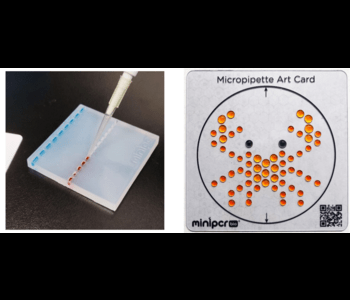Four tools for teaching biotech to beginners
By Ally Huang, PhD, Scientist at miniPCR bio
Clinical Laboratory Technician, Biofuel Engineer, Molecular Biology Technician, Quality Control Chemist—even Brewmaster. What do all of these jobs have in common? They all require skills in biotechnology!
The need for individuals trained in biotechnology techniques continues to grow. The field of biotechnology technicians is expected to grow by almost 10% over the next ten years; several other biotechnology related careers are expected to grow even faster. Give your students a head start by introducing them to biotechnology early!
It is easier than you think to bring introductory-level biotechnology to your classroom. miniPCR bio™ pioneered bringing accessible PCR and electrophoresis into classrooms.

Lay the foundations early for a career in biotech!

Silicone practice gels and micropipette art: Two tools for biotech learners
Here are four tools that lower the boundaries to biotech access even further:
- Bandit™ STEM Electrophoresis Kit: Bandit is the DIY kit that leads students through the process of building and running a working gel electrophoresis system. By building the system, students develop a deep understanding of the science behind electrophoresis. Build it to understand it!
- Silicone practice gels: Silicone practice gels are like training wheels for loading agarose gels. Similar in look and feel to the real thing, but made from durable silicone that can’t be punctured by a wayward micropipette tip, practice gels give students a chance to build muscle memory without puncturing painstakingly-poured agarose gels.
- Minipettes: Minipettes are fixed-volume micropipettes that offer the look and feel of “the real thing” while reducing the margin for error that comes with dialing in volumes. Students can build confidence as they practice with minipettes, and carry their skills over to variable micropipettes when they are ready.
- Micropipette art: Great for engaging science nerds and self-proclaimed non-scientists alike, micropipette art lowers the stakes and makes pipetting fun. Students can follow our ‘Pette-by-Number templates to make pipette art masterpieces, or use our blank grids to come up with their own creations.
For a first exposure to biotechnology, you want your students to get hands-on practice with biotechnology methods, with engaging curriculum, at an affordable price.
That’s why we included all four of these tools in our Bandit™ Biotech Bundle. In this convenient and affordable kit, you’ll find all the essentials you need to introduce your students to modern laboratory techniques.

Related resources:
-
Bandit™ Biotech Bundle product page
-
miniPCR Tutorials – videos, worksheets, readings, and more to introduce your students to biotech methods like PCR and gel electrophoresis
-
DNAdots – simple, two-page readings in non-technical language explaining cutting-edge biotechnology




